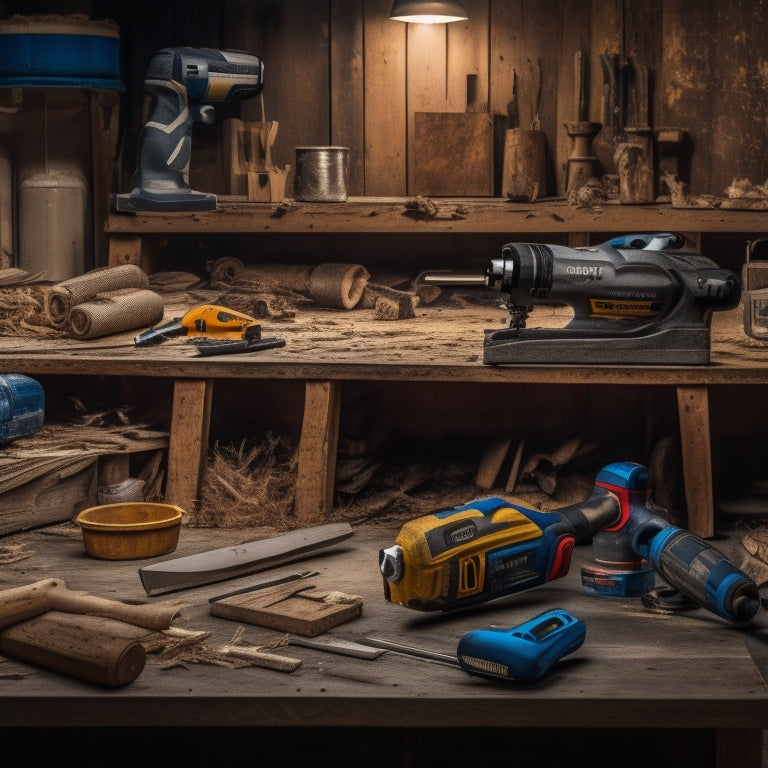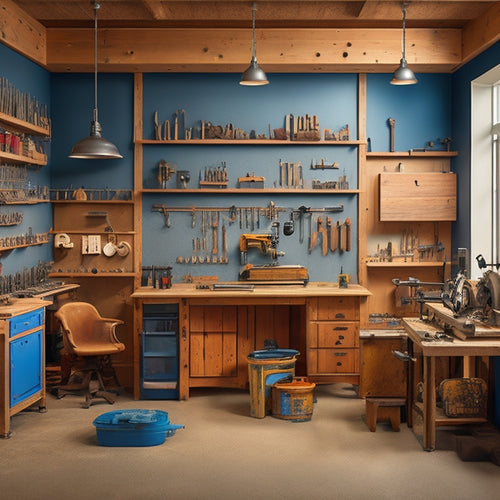
10 Best Power Tools to Buy for Home Renovation
Share
To tackle your home renovation project efficiently, you'll need the right power tools for the job. A cordless drill for concrete walls, impact driver for heavy screws, and rotary hammer for demolition work are essential for heavy-duty tasks. For precision cuts, consider a reciprocating saw for pruning trees, circular saw for clean cuts, and a router for smoothening edges. A sander will help with finishing touches, while a multitool provides versatility and a laser level guarantees accurate measurements. With these top power tools in your arsenal, you'll be well-equipped to take on any renovation project - and discover the specific features and techniques that'll make all the difference.
Key Takeaways
- For drilling and driving, prioritize a cordless drill with high torque and advanced battery technology for effective concrete drilling and longer runtime.
- Demolition and cutting tasks require specialized tools, such as a rotary hammer for heavy-duty tasks and a reciprocating saw for pruning trees.
- Finishing tools like routers and sanders are crucial for achieving a high-gloss finish, with proper bit and grit selection being key to desired results.
- Multitools and laser levels offer versatility and precision, enabling quick function switching and ensuring accurate measurements in renovation projects.
- Consider tool durability, comfort, and safety features when selecting the best power tools for your home renovation project.
Cordless Drill for Concrete Walls
Three key considerations come into play when selecting a cordless drill for concrete walls: torque, battery life, and durability.
You'll want a drill that can deliver high torque to power through tough concrete, so look for a model with a high torque rating.
Battery life is also vital, as you don't want your drill to run out of juice in the middle of a project. Opt for a drill with advanced battery technology, such as lithium-ion batteries, which offer longer runtime and faster charging.
Durability is also essential, as concrete drilling can be rough on your tools. Look for a drill with a rugged design and high-quality construction.
Additionally, consider the drill accessories that come with your tool. Do you get a variety of drill bits, including those specifically designed for concrete? Are there any additional features, such as a built-in level or LED light, that can make your drilling tasks easier?
Impact Driver for Heavy Screws
When tackling heavy screws, you need an impact driver that can deliver the necessary force to get the job done efficiently. An impact driver's benefits lie in its ability to provide high torque and speed, making it perfect for driving large screws, lag bolts, and anchors.
Choosing the right impact driver for your project is vital, as it can considerably reduce the time and effort required to complete the task.
When selecting an impact driver, consider the type of screws you'll be working with and the material you're driving them into. A higher torque rating is necessary for driving larger screws into dense materials like hardwood or metal. Additionally, look for an impact driver with adjustable torque settings to prevent stripping or breaking screws.
A high-quality impact driver should also have a comfortable grip and ergonomic design to reduce fatigue during extended use. Brushless motors provide increased efficiency and longer tool life, making them a worthwhile investment for frequent users.
Rotary Hammer for Demolition Work
You'll need a reliable rotary hammer for demolition work that involves breaking up concrete, removing tile, or chiseling through masonry. This powerful tool is designed to withstand the rigors of heavy-duty demolition projects, providing the force and precision you need to get the job done efficiently.
When selecting a rotary hammer, look for one with high-torque output, adjustable speed, and a robust motor that can handle demanding tasks.
When it comes to demolition techniques, a rotary hammer is ideal for breaking up concrete slabs, removing tile, and chiseling through masonry. With the right bit, you can also use it for drilling through concrete or brick.
To guarantee tool safety, always wear protective gear, including gloves, safety glasses, and a dust mask. Additionally, make sure the work area is clear of debris and obstacles, and maintain a firm grip on the tool to avoid loss of control.
Reciprocating Saw for Pruning Trees
Through dense foliage or overgrown branches, a reciprocating saw is the ideal power tool for pruning trees, allowing you to make precise cuts with ease. This saw's versatility and maneuverability make it perfect for maneuvering tight spaces and tackling thick branches.
For effective tree pruning, you'll want to choose the right blade for the job. Opt for a wood-cutting blade with a high tooth count for cleaner cuts and less splintering. A blade with a length of 6-8 inches will provide the best balance between cutting capacity and control.
When using a reciprocating saw for tree pruning, maintain a firm grip and keep the saw straight. Apply gentle to moderate pressure, depending on the branch's thickness. Make slow, deliberate cuts, following the natural direction of the branch.
Avoid applying too much pressure, as this can cause the saw to bind or kickback. With the right blade selection and proper technique, a reciprocating saw will make quick work of even the most overgrown trees, leaving your yard looking neat and tidy.
Circular Saw for Clean Cuts
After pruning those overgrown branches, it's time to shift your focus to making clean cuts for your home renovation project. A circular saw is your go-to tool for this task. With the right saw blade type and cutting technique, you'll achieve precise cuts that'll make your project shine.
| Saw Blade Type | Cutting Technique | Material |
|---|---|---|
| Fine-tooth blade | Slow, controlled cuts | Plywood, MDF |
| Coarse-tooth blade | Fast, aggressive cuts | Lumber, 2x4s |
| Diamond blade | Smooth, precise cuts | Concrete, tile |
When choosing a saw blade, consider the material you're working with. Fine-tooth blades are ideal for plywood and MDF, while coarse-tooth blades are better suited for lumber and 2x4s. Diamond blades, on the other hand, are perfect for concrete and tile. Remember to adjust your cutting technique accordingly, taking into account the speed and pressure you apply. With the right combination, you'll achieve clean, accurate cuts that'll elevate your home renovation project.
Jigsaw for Curved Lines
For curved lines and intricate cuts, a jigsaw is the perfect power tool for your home renovation project. This versatile tool allows you to make precise, curved cuts in various materials, including wood, metal, and plastic.
When choosing a jigsaw, consider the type of blade you need. There are three main jigsaw blade types: high-carbon steel blades for wood and plastic, bi-metal blades for metal and wood, and diamond-coated blades for tile and concrete.
To guarantee safe operation, always follow jigsaw safety tips. Wear safety glasses and a dust mask to protect yourself from debris and dust. Keep your work area clean and clear of clutter to prevent accidents.
Hold the jigsaw firmly, but not too tightly, and maintain control as you make your cuts. Keep your fingers away from the blade, and avoid cutting in areas with loose clothing or jewelry that could get caught.
With the right jigsaw and proper safety precautions, you'll be able to make precise, curved cuts with ease, taking your home renovation project to the next level.
Router for Smoothening Edges
You've made precise curved cuts with your jigsaw, but now it's time to focus on smoothening those edges. A router is the perfect tool for this task, as it allows you to apply edge profiling techniques to create a professional-looking finish.
When selecting a router, take into account the type of projects you'll be working on and the size of the areas you need to smoothen.
Router bit selection is vital in achieving the desired edge profile. Here are three key factors to keep in mind when choosing a router bit:
- Bit type: Straight bits are ideal for smoothening flat edges, while chamfer bits are better suited for creating decorative edges.
- Bit diameter: Choose a bit that matches the width of the area you need to smoothen.
- Bit material: Carbide-tipped bits are durable and long-lasting, making them a popular choice for heavy-duty projects.
Sander for Finishing Touches
Smoothening edges is just the beginning - now it's time to focus on achieving a flawless finish with a sander.
When it comes to sander types, you'll need to choose between belt sanders, orbital sanders, and detail sanders, each designed for specific finishing techniques. Belt sanders are ideal for large, flat surfaces, while orbital sanders excel at removing imperfections and small scratches. Detail sanders, on the other hand, are perfect for tight spaces and intricate work.
When selecting a sander, consider the grit range, as it'll determine the level of finish you can achieve. Start with coarse grits (80-120) for removing old finishes and work your way up to finer grits (220-240) for a high-gloss finish.
Don't forget to follow proper finishing techniques, such as working progressively through grits, keeping the sander moving, and applying even pressure.
With the right sander and techniques, you'll be able to achieve a showroom-quality finish that'll make your renovation project stand out.
Multitool for Versatility
As you tackle various tasks in your home renovation project, you'll appreciate the convenience of a multitool that can adapt to different situations.
A multitool's versatility comes from its interchangeable accessories, which allow you to switch between various functions quickly. This feature is especially useful when working in tight spaces or when you need to make precise cuts.
When choosing a multitool, consider the following key factors:
- Accessory compatibility: Verify the multitool is compatible with a wide range of accessories, such as blades, sanding pads, and grout cleaners.
- Ergonomic design: Opt for a multitool with a comfortable grip and balanced design to reduce fatigue during extended use.
- Multitool maintenance: Look for a tool with easy-to-clean components and minimal maintenance requirements to guarantee peak performance.
Laser Level for Accurate Measurements
With your multitool handy, you're ready to tackle a variety of tasks, but accurate measurements are critical to guaranteeing your renovation project stays on track.
That's where a laser level comes in – a precision instrument that guarantees perfect horizontal and vertical alignment. This leveling tool advantage allows you to achieve precise measurements, eliminating errors and saving time.
When choosing a laser level, consider one with advanced laser calibration techniques, guaranteeing accurate readings even on uneven surfaces.
Look for a model with a high level of accuracy, typically ±1/16 inch at 100 feet. A self-leveling feature is also essential, as it automatically adjusts to the surrounding environment.
Additionally, consider a laser level with a durable design, resistant to dust and water, and a long battery life to minimize downtime.
Frequently Asked Questions
Can I Use a Power Tool With an Extension Cord Outdoors?
When working outdoors with power tools and extension cords, you'll want to prioritize safety precautions. Make certain your extension cord's ratings match the tool's power requirements, and always check the cord's condition and certification for outdoor use to avoid electrical hazards.
How Often Should I Clean and Maintain My Power Tools?
You should establish a maintenance schedule to clean your power tools regularly, ideally after each use, to prevent dust and debris buildup, ensuring peak performance and extending their lifespan.
Are Power Tools Suitable for People With Arthritis or Joint Pain?
As you grip the tool, precision meets comfort; ergonomic designs and adaptive accessories can be your game-changer, allowing you to master tasks despite arthritis or joint pain, empowering you to take control of your project.
Can I Use Power Tools in Areas With High Humidity or Moisture?
When working in humid or moist areas, you'll need to take humidity effects into account to guarantee safety; always follow safety precautions like waterproofing, grounding, and regular maintenance to prevent electrical shock and tool damage.
Do Power Tools Come With a Warranty or Guarantee?
When you buy power tools, you typically get a warranty that covers defects and repairs for a specific period, ensuring tool longevity; you'll want to review the warranty coverage to know what's protected and for how long.
Conclusion
As you wrap up your home renovation, you're likely to look back and think, "I'm glad I invested in those power tools!" It's no coincidence that the 10 tools on this list have become your go-to companions, making the impossible possible. With them, you've drilled through concrete, driven heavy screws, and smoothed out rough edges. Your home renovation journey may be ending, but the memories (and your new skills) will last a lifetime.
Related Posts
-

Top Tools for DIY Home Renovation Plastering Success
To achieve DIY home renovation plastering success, you'll need a range of essential tools. Start with hand tools like...
-

Renovation Tool Checklist for Smooth Finishes
When tackling a renovation project that requires a smooth finish, you'll need a thorough tool checklist to guarantee ...
-

7 Best Tool Storage Ideas for Home Renovation
When it comes to home renovation, staying organized is key to maximizing productivity and minimizing wasted time. To ...


